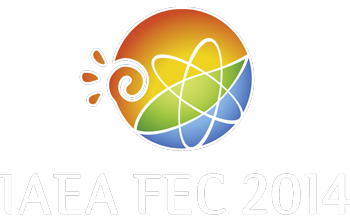Speaker
Prof.
Yasushi Ono
(University of Tokyo)
Description
We have been developing a new type of divertor concept: “dynamic divertor” composed of periodic ejection of plasmoid from a core-plasma and its gas-puff cooling, to reduce significantly heat flux to divertor plates. Our TS-4 experiment and PIC simulation consistently solved the plasmoid formation and pinch-off mechanisms essential to the dynamic divertor operation. We found the acceleration dV/dt of plasmoid promotes its pinch-off from the core-plasma through fast reconnection and also that the external inflow flux controlled by the external coil current increases with the plasmoid size. In TS-4, the X-point region between the ST plasma and the divertor plate are formed by induction of two poloidal field (PF) coils. The corresponding plasmoid ejection was observed in 2-1/2D Full PIC simulation (PASMO) with 2×10^10 particles in a domain of (x, y) = (512, 256) Debye length under uniform guide field ~ 4 reconnecting magnetic field. The maximum acceleration rate dV/dt of plasmoid occurs simultaneously with the maximum reconnection electric field E_t, indicating that the acceleration rate of plasmoid is directly connected with the reconnection time - the plasmoid pinch-off time like the coronal mass ejection in the solar flares. The plasmoid ejection from the current sheet reduces significantly its thermal/ magnetic pressures, causing further thinning of the current sheet. When the current sheet is compressed thinner than the ion meandering length (ion gyro-radius), its effective resistivity tends to increase significantly, causing its anomalous dissipation and thus faster reconnection rate, both in TS-4 experiment and the PIC simulation. They agree in the normalized plasmoid ejection time ~5 Alfven time but E_t and dV/dt in the former is 70% and 50% of those in the latter, probably due to low downstream magnetic pressure in the slab model simulation. The PIC simulation also indicates that the heat flux from the core-plasma is transported along the separatrix field line and confined in the plasmoid. The field-aligned velocity component is essential to the plasma transport from the core-plasma to the plasmoid, which indirectly connects them for the gas-puff cooling.
| Country or International Organisation | University of Tokyo, Japan |
|---|---|
| Paper Number | PD/P5-5 |
Author
Prof.
Yasushi Ono
(University of Tokyo)
Co-authors
Prof.
Chio Zong Cheng
(University of Tokyo)
Prof.
Ritoku Horiuchi
(National Institute for Fusion Science)
Mr
Shizuo Inoue
(Univ. Tokyo)
Dr
Yoshinori Hayashi
(University of Tokyo)

